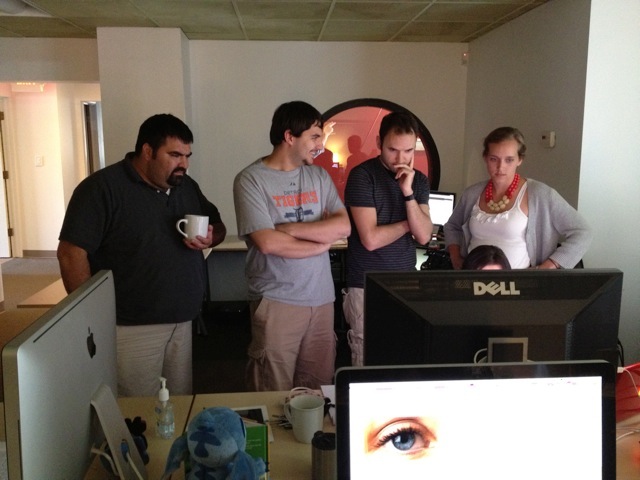Microsoft clearly needs to get closer to developers and the company's latest efforts pretty much make sense. Windows 8 relies on a whole new concept that turns developers into key players for the overall success of the new operating system, as users need as many Metro apps as possible.
And still, designing a Windows 8 app could be a challenging task. Many have tried it, but only a few have managed to create something that's at least worth a look. Toolbox for Windows 8 is one of the apps that could convince you to install it in just a second.
To get more details about this successful app story and to get to know the way developers see the new Windows 8, we had a talk with Kevin Foreman, director of product vision for Vectorform, the company behind Toolbox for Windows 8.
Softpedia: Introduce yourself to our readers and talk a little bit about your role in the development of Toolbox for Windows 8.
Kevin Foreman: Hello! My name is Kevin Foreman and I am the Director of Product Vision for Vectorform. Our focus is to bring new concepts and innovative experiences to emerging technologies and platforms.
My background is primarily in development where I have worked on platforms such as Android, Microsoft Kinect, Xbox 360, webOS, iOS, Microsoft Pixel Sense, and the assorted versions of the Windows operating system.
I often describe my role as an "App Director." Similar to a movie director, I set a vision for the entire experience and work with each team to execute on that vision.
The vision for Toolbox was driven largely by the trend with recent mobile operating systems where they trade productivity and control for simplicity. For smaller devices such as phones, this makes sense. However, for tablets and other larger-screen devices, we felt that there was an opportunity to take advantage of this under-utilized screen real estate.
Our mission was to prove that simplicity and productivity are not mutually exclusive, and to provide a true multitasking environment for the touch-computing era. With Windows 8 focusing on tablets and other touch computing devices, we felt there was no better platform to introduce this concept with.
Softpedia: At this point, Toolbox for Windows 8 is one of the most popular apps in the Windows Store, with more than 1250 ratings and quite a lot of reviews. Did you expect to enjoy such a terrific success before launching the app?
Kevin Foreman: We knew early on that we had something very unique with Toolbox. We were very excited to see how it was adopted by consumers. However, there were a lot of unknowns around the launch of Windows 8.
With the new Modern interface, addition of the app store, and a focus on tablets, there was some uncertainty as to how this entire new ecosystem would flourish. I wouldn’t say we “expected” success, but we designed and developed an experience that we felt had the best chance at achieving it.
And achieve it, we did.
Toolbox has topped the charts since the launch of Windows 8, achieving the #1 spot in Productivity. It was also ranked in the top 10 of all Windows 8 applications. Our average time of use per day, per user, is ~20 minutes, which is pretty incredible given the in/out app-syndrome that we all seem to have.
We’re very proud of the success Toolbox has achieved and are working hard on maintaining this momentum with more Tools, features, and enhancements over the lifetime of the platform.
Softpedia: Toolbox currently packs 12 different tools and according to the Windows Store description, many more are on their way. Could you share some of your plans for the app with our readers?
Kevin Foreman: Absolutely. Toolbox was designed from the ground up to be an ever-growing platform of productivity-enhancing tools, or mini applications. We’re working hard on bringing great new additions to your Toolbox. We’ve already released our Stopwatch, Notes, and Twitter Tools to great reception, and have 6 new tools that we will be releasing in the coming weeks.
We’re always looking for feedback on new tools and features, and we invite any of our users to contact us via the email address included in the about section of Toolbox.
Softpedia: The Twitter client included in Toolbox is quite impressive. Still, given its $4.99 price tag, some users may stick to the other Twitter clients in the Store. How many users do you think would agree to buy your Twitter app and why should they do it?
Kevin Foreman: Great question! Twitter has been, by far, our most requested Tool. We wanted to take that opportunity to create the absolute best Twitter client available for Windows 8. We spent a considerable amount of time designing and refining the interface to make it easy to manage all of Twitter’s features and activity views.
The design is centered around what we call our 3-pane view, which allows you to keep an eye on three configurable views at once. Those views are: Timeline, Connect, Trend, Profile, Pictures, Details, Messages, and Search. You’re free to mix and match them as you would like. Our views update in real-time, giving you up-to-the-second updates of your Twitter stream. By itself, it is one of the most powerful Twitter clients available for any platform.
However, combined with the rest of the Toolbox framework and its tools, the power and customization of your Twitter experience is unmatched. You can keep an eye on Twitter, Facebook, your favorite websites, take notes, set alarms, make calculations, check the weather, record voice notes, and much more all within one app/experience without ever having to switch apps or views.
Note, with Twitter’s recent policy update, we’re only allowed to sell 100,000 units of the Twitter tool before we have to remove it for sale permanently. It’s highly unfortunate, but it is out of our control. If you’re interested in the Twitter tool, don’t miss your chance to own it. However, any purchased Twitter tool will continue to work and receive updates even after the 100,000 limit has been reached.
Softpedia: Windows 8 success stories are all over the world, with some devs claiming that they’ve made thousands of dollars with their Modern apps. What are the chances to make a fortune out of a Windows 8 app?
Kevin Foreman: With over 100 million Windows 8 licenses sold, there is an incredible opportunity in attaining revenue within the Windows 8 app store. There are also relatively (in comparison with iOS and Android) few apps on the platform, which is actually an advantage for developers. Fewer apps allow for more visibility and awareness of your app, but this is becoming less of an advantage as more apps are released on the Windows 8 store.
There are, of course, no guarantees of success for any application. However, if you release a highly polished experience that aims to solve a pain point of current Windows 8 users, your chance at success is quite high.
Softpedia: Microsoft still struggles to get closer to developers and the reason is pretty much obvious: Windows 8 needs more Modern apps as soon as possible. How important do you think it is for the Redmond-based company to get in touch with developers?
Kevin Foreman: I am not sure the quantity of Modern apps is the problem, but rather the limited set of functionality developers have within Modern apps. Windows has always been very open in terms of what developers have access to. This allowed for very powerful applications that many of us have grown accustom to over the last 20 years.
However, with Modern apps, we’re no longer allowed access to many of the underlying Windows frameworks, and instead we are sandboxed within the new WinRT framework. There are both advantages and disadvantages to this model, and developers are still learning how to take advantage of this new framework.
As Windows 8 and WinRT mature, I believe Microsoft will begin to open up additional functionality that will allow for more robust Modern apps. With Toolbox, we’ve pushed WinRT to the limits, as we created our own powerful windowing framework that allows for true multitasking. We’re very eager to implement additional functionality that is currently not included in the WinRT framework.
Softpedia: How would you describe the process of creating a Windows 8 Modern app?
Kevin Foreman: Microsoft has always created great tools for developing and creating applications for their platform, and Modern apps are no different. There are many great examples, documentation, and sample applications to help get your idea up and running.
The most difficult aspect of creating a Windows 8 Modern app is actually finding the right idea to develop. What concept makes sense to have on your desktop and tablet alike? Is there a specific pain point users on Windows 8 are experiencing, and if so, how would you improve on that?
Microsoft has essentially removed the complexity of distribution, marketing, hosting, and e-commerce away from the developer, and allowed developers to focus on the execution of the concept they’re looking to bring to the platform.
Softpedia: Overall, what’s your opinion on Windows 8? It remains a very controversial product and some say that the lack of Modern apps is one of the main drawbacks.
Kevin Foreman: We believe that Windows 8 has brought some great new concepts to the table, and we’re very excited to have one of the most downloaded applications on the platform to date with Toolbox.
Windows 8 was a necessary transition for Microsoft to adapt to the changes in how we interface with computing devices. It’s no easy task to completely change the way you use an operating system that is so universally used throughout the world, and the work Microsoft has done in Windows 8 lays a great foundation for the future of the Windows operating system.
For developers, the Windows Store is a great market for publishing applications to one of the largest userbases in all of technology, and the tools Microsoft provides make it easy to build, manage, and maintain those applications.
While it may take some time for the average consumer to fully embrace the new interface Windows 8 has introduced, the library of Modern apps will continue to grow, bringing great new experiences to the platform.
Softpedia: Do you think that a Start button would make Windows 8 more appealing? Kevin Foreman: I am not sure adding the Start button back would make Windows 8 more “appealing”, but rather more familiar. The new Start screen has a lot of advantages, with some major drawbacks. I would prefer Microsoft to fix the drawbacks instead of reverting back to the old, familiar, design of the Start menu.
There is no doubt that Windows 8 has a learning curve, but so did Windows 95 and we all grew accustomed to that. The mouse and keyboard were fantastic human-interface devices, but I wouldn’t say they are the absolute best way to interact with a computer. As we evolve our interactions, our UI has to evolve with it, and reverting back to a UI design that was introduced nearly 20 years ago isn’t allowing for evolution.
Softpedia: Are you planning to release any other Windows 8 Modern app in the future?
Kevin Foreman: We have a number of Windows 8 projects in process, including projects that are primarily design and some that are both design and development. We hope to be able to share updates with you soon!

 14 DAY TRIAL //
14 DAY TRIAL // 
